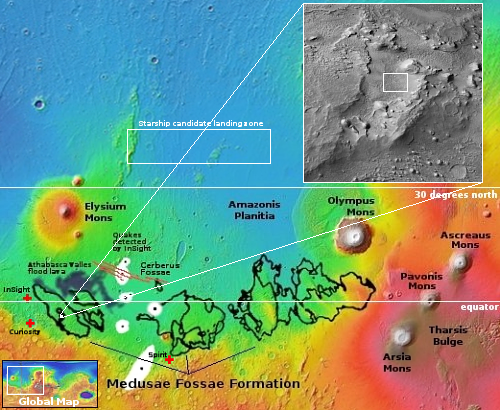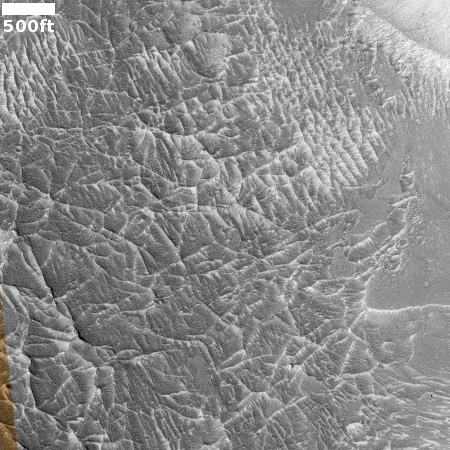Boxwork in the dry Martian tropics
Cool image time! The picture to the right, cropped and enhanced to post here, was taken on July 17, 2024 by the high resolution camera on Mars Reconnaissance Orbiter (MRO). It shows what the scientists label as boxwork, a pattern of intersecting straight ridges criss-crossing each other in a generally random manner.
The ridges themselves are very small, only a few feet high. To make them more visible I have purposely cropped this section without reducing its resolution. I have also increased the contrast.
What caused them? According to this paper [pdf] about similar boxwork found on Mount Sharp in Gale Crater, the boxwork “formed when cements filled existing pore spaces and fractures in fractured rock, and these cements were left as topographic ridges after erosion.”
In other words, the surface hardened, then fractured. Later more resistent material, likely lava, filled the cracks. When erosion later stripped the top surface away, the lava was more resistent and so became the ridges we now see.

On the overview map to the right, the white dot about 275 miles east of Curiosity in Gale Crater marks the location. The rectangle in the inset shows the area covered by the picture above. This boxwork covers the floor of a mile-wide bowl, set between a larger 40-mile-wide region of plateaus, knobby plains, and larger ridges. This larger patch of rocky terrain is in turn surrounded by the Medusa Fossae Formation, the largest volcanic ash deposit on Mars. In Medusa the bedrock is generally covered deeply by that ash. Here however we are looking mostly at bedrock.
Though lava is the likely material that filled the cracks and formed these ridges, the fracturing is often theorized to have involved water. Initially the ground was impregnated with water or ice, and as that sublimated away the ground dried and formed the kind of polygonal cracks seen in dried mud on Earth.
Though this boxwork (as well as the boxwork on Mount Sharp) is in the middle of the dry tropics of Mars, its existence suggests the possibility of past water processes that are worth investigation. Thus, sometime in the next few years the Curiosity rover team hopes to reach the boxwork high on Mount Sharp to get a closer look.
On Christmas Eve 1968 three Americans became the first humans to visit another world. What they did to celebrate was unexpected and profound, and will be remembered throughout all human history. Genesis: the Story of Apollo 8, Robert Zimmerman's classic history of humanity's first journey to another world, tells that story, and it is now available as both an ebook and an audiobook, both with a foreword by Valerie Anders and a new introduction by Robert Zimmerman.
The print edition can be purchased at Amazon or from any other book seller. If you want an autographed copy the price is $60 for the hardback and $45 for the paperback, plus $8 shipping for each. Go here for purchasing details. The ebook is available everywhere for $5.99 (before discount) at amazon, or direct from my ebook publisher, ebookit. If you buy it from ebookit you don't support the big tech companies and the author gets a bigger cut much sooner.
The audiobook is also available at all these vendors, and is also free with a 30-day trial membership to Audible.
"Not simply about one mission, [Genesis] is also the history of America's quest for the moon... Zimmerman has done a masterful job of tying disparate events together into a solid account of one of America's greatest human triumphs."--San Antonio Express-News
Cool image time! The picture to the right, cropped and enhanced to post here, was taken on July 17, 2024 by the high resolution camera on Mars Reconnaissance Orbiter (MRO). It shows what the scientists label as boxwork, a pattern of intersecting straight ridges criss-crossing each other in a generally random manner.
The ridges themselves are very small, only a few feet high. To make them more visible I have purposely cropped this section without reducing its resolution. I have also increased the contrast.
What caused them? According to this paper [pdf] about similar boxwork found on Mount Sharp in Gale Crater, the boxwork “formed when cements filled existing pore spaces and fractures in fractured rock, and these cements were left as topographic ridges after erosion.”
In other words, the surface hardened, then fractured. Later more resistent material, likely lava, filled the cracks. When erosion later stripped the top surface away, the lava was more resistent and so became the ridges we now see.

On the overview map to the right, the white dot about 275 miles east of Curiosity in Gale Crater marks the location. The rectangle in the inset shows the area covered by the picture above. This boxwork covers the floor of a mile-wide bowl, set between a larger 40-mile-wide region of plateaus, knobby plains, and larger ridges. This larger patch of rocky terrain is in turn surrounded by the Medusa Fossae Formation, the largest volcanic ash deposit on Mars. In Medusa the bedrock is generally covered deeply by that ash. Here however we are looking mostly at bedrock.
Though lava is the likely material that filled the cracks and formed these ridges, the fracturing is often theorized to have involved water. Initially the ground was impregnated with water or ice, and as that sublimated away the ground dried and formed the kind of polygonal cracks seen in dried mud on Earth.
Though this boxwork (as well as the boxwork on Mount Sharp) is in the middle of the dry tropics of Mars, its existence suggests the possibility of past water processes that are worth investigation. Thus, sometime in the next few years the Curiosity rover team hopes to reach the boxwork high on Mount Sharp to get a closer look.
On Christmas Eve 1968 three Americans became the first humans to visit another world. What they did to celebrate was unexpected and profound, and will be remembered throughout all human history. Genesis: the Story of Apollo 8, Robert Zimmerman's classic history of humanity's first journey to another world, tells that story, and it is now available as both an ebook and an audiobook, both with a foreword by Valerie Anders and a new introduction by Robert Zimmerman.
The print edition can be purchased at Amazon or from any other book seller. If you want an autographed copy the price is $60 for the hardback and $45 for the paperback, plus $8 shipping for each. Go here for purchasing details. The ebook is available everywhere for $5.99 (before discount) at amazon, or direct from my ebook publisher, ebookit. If you buy it from ebookit you don't support the big tech companies and the author gets a bigger cut much sooner.
The audiobook is also available at all these vendors, and is also free with a 30-day trial membership to Audible.
"Not simply about one mission, [Genesis] is also the history of America's quest for the moon... Zimmerman has done a masterful job of tying disparate events together into a solid account of one of America's greatest human triumphs."--San Antonio Express-News


